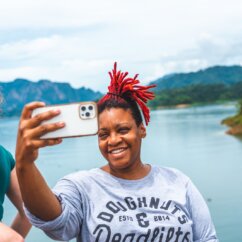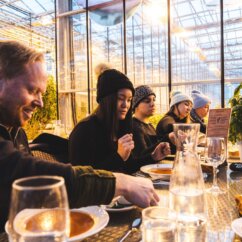Inside South Korea’s healing cafés
Anna Brech
Fast healing is becoming big business in South Korea, with the emergence of specially designed healing cafés offering a quick fix of urban zen
https://www.instagram.com/p/BtqDbnDFNIQ/?utm_source=ig_embed
Imagine if you popped to your local café not only for a caffeine fix – but also for a quick nap, a foot massage and an express counselling session. That’s the case in South Korea, where a booming café scene is giving rise to a trend for so-called “fast healing”. These cozy nooks can be found cropping up across the country’s major cities, offering hammocks, massage chairs and ambient plant life to a generation of exhausted office workers.
According to the latest data from the Organization for Economic Cooperation and Development (OECD), South Koreans get the least sleep of 26 nations surveyed; and the government’s health service has recorded a sharp increase in sleep disorders over the past four years. Add to this an endemic culture of grafting – South Koreans put in an average of 400 hours more work than their UK and Australian counterparts per year – and it’s clear that people here are in need of a break. Healing cafés provide that avenue, carving out space to unwind and refresh in an ever-frantic world.
In search of a midday snooze
https://www.instagram.com/p/Bkq3uZ8AqF1/?utm_source=ig_embed
Forget about some snatched shut-eye on the train: healing cafés provide a legitimate space for midday snoozing. “The customers vary from people who come alone to couples, friends, families, travelers – simply anyone who needs a break in their life,” Park Hye-sun, manager of the Mr. Healing café, tells the Korean Herald. Mr. Healing owns a fast-growing franchise of cafés across the country, where customers book in for a 30 or 50-minute nap in specially formulated massage capsules.
https://www.instagram.com/p/BoGYF1wAcYK/?utm_source=ig_embed
Set in their own cubicles, these reclining structures (above) are programmed to a series of modes that gently pummel the body and promote a state of deep relaxation. “In a healing café, you’ll find super deluxe massage chairs straight out of some Sci-Fi movie designed to poke, prod, and massage your body into a blissful state of being,” writes South Korea blogger Brian Dye. “[…] I didn’t know at the time, but the attendant later explained that it all works due to a series of air bags that alternately compress, rub, and roll over your muscles from the bottom of your feet to the top of your head. It’s heaven.” Customers can also wear eye masks, and soothing scents such as lavender and rosemary are pumped through the room to heighten the feeling of zen.
Shim Story, another popular healing space in Seoul’s Gangnam district, offers pods with heated beds, bean bags, table lamps and headphones. Guests can retreat within, resting and recharging in the midst of a gruelling day. At First Class Café in the Hongdae area of Seoul, relaxation pods are modelled on a First Class airline experience complete with express massages and waffles on demand (just because). Similar hubs provide hammocks, stone beds or generously cushioned chill-out areas, where the lighting is dimmed along with soothing classical or nature soundtracks.
Fast relaxation for frantic times
https://www.instagram.com/p/Bxlg-MzlMIw/?utm_source=ig_embed
As the popularity of healing cafés grow, the line between public and private space is being eroded. It’s an intentional move on behalf of the entrepreneurs behind the movement, who have designed their cafés to emanate the cosiness and warmth of someone’s home. In that way, visitors are invited to take ownership of the space in a manner that is markedly different from your average coffee shop.
“There is no place in Korea to stretch one’s legs before returning home, so I decided to open a relaxing lounge that is as comfortable as home,” Shim Story founder Jung Oon-mo tells JWTIntelligence. “[…] Coffee shops don’t allow people to rest, so lounges can help them spend time well while away from home through four different themes: sleeping, relaxing, massage and talking.”
https://www.instagram.com/p/t9e9gtmAIX/
Healing cafés, then, occupy a unique space between the slow relief of a spa and the speedy delivery of a Starbuck’s, creating what the Korea Times terms a “fast-healing market” where “people look for a quick remedy for relaxation the same way they consume fast foods”. You don’t have to devote an entire weekend to relaxation, as with a spa retreat, but instead grab a quick fix refuel in the midst of the working day. And while some therapists may argue that the idea of speedy wellness is counter-intuitive, there is an appealing logic to the concept. In an age where our lives are busier than ever before, healing is integrated into that churn. You make time for it because you can; all in one lunch break.
Space for physical and mental wellness
https://www.instagram.com/p/Bw1mZrZBBoW/?utm_source=ig_embed
Healing cafés reach beyond simply napping or relaxing, too. They’re about taking time out for things that might well get neglected in day-to-day life. Creativity, social connectivity, space for reflection: these are all vital ingredients of wellbeing that often get swept to one side. But, as South Korea’s café industry continues to diversify and play with the boundaries between work and home, they’re also carving out room for these elements. Peach Gray in Seoul, for example, is not a healing place per se but it does offer punters a winning combination of painting and pancakes. Via watercolour sets that arrive side-by-side with picturesque drinks and snacks (above), you can reap the proven mood benefits of colouring here for as long as you want.
https://www.instagram.com/p/BxMdVW8hDKx/?utm_source=ig_embed
Elsewhere in the country, cafés are experimenting with a raft of design elements – twinkling lanterns, cushion rooms, a jungle of plant life – that foster a warm, inclusive atmosphere. This lounge-like experience often runs alongside the more obvious healing elements, such as foot spas or nap pods, so customers can recharge with a smoothie after their nap and connect with one another. As the Korea Times reports, even CGV, the country’s leading cinema chain, is joining the movement with lunchtime siesta sessions where clients can stretch out in reclining chairs at some of their most popular movie theatres, listening to relaxing forest tracks.
According to this ArirangTV video, some healing cafés also focus on mental health in a more literal way. Visitors can take advantage of express one-on-one counselling sessions with qualified therapists, using the café lounge as a base. Whether it’s a dark cocoon to nap in or a place of acceptance where you can let off steam, healing cafés are pushing the scope of what modern-day wellness means. And instead of grabbing a sandwich come lunchtime, stressed city workers in South Korea are increasingly seeking comfort and solace within.
Main image: Yoann Boyer on Unsplash, others: Instagram





